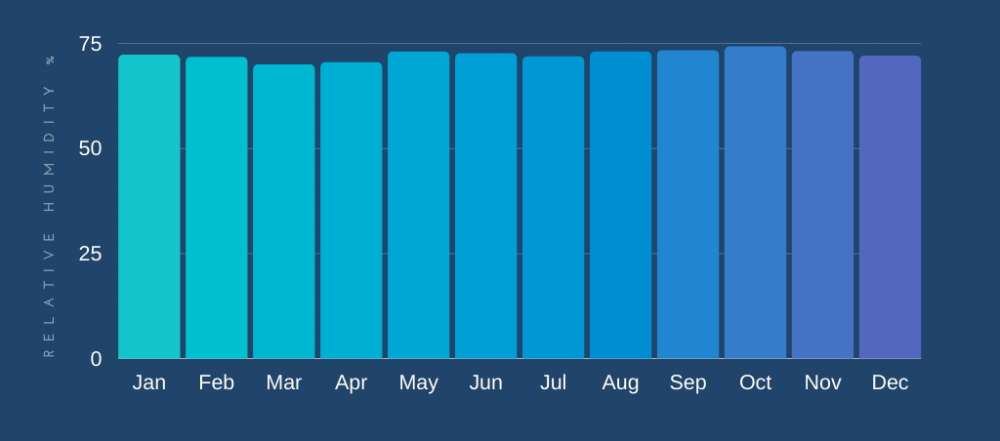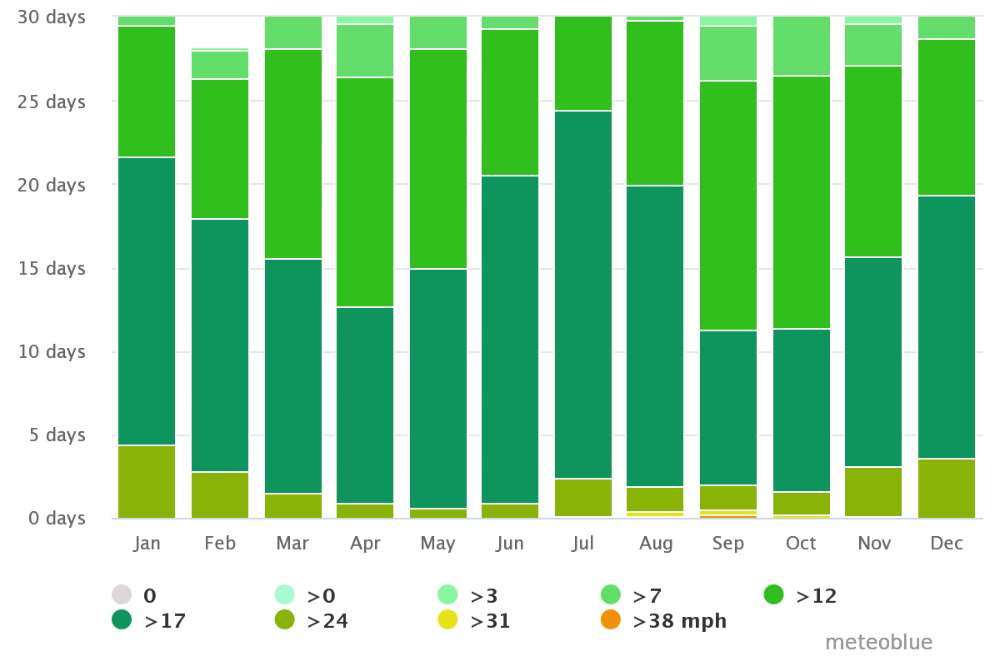
The weather throughout St. Barts is remarkably consistent. Unlike larger islands like Jamaica, the Dominican Republic or Guadeloupe where the weather can vary greatly from one side of the island to the other. Here in St Barts temperature, humidity, hours of sunshine and rainfall vary little from place to place or month to month.
The island of St Barts is cooled by consistent tradewinds from the west for most of the year. The wind tends to pick up in July and August.
Although January through March are the cooler months with less humidity, the average high and low temperatures for the first quarter of the year are typically only a few degrees lower than in September, which is the warmest and wettest month on the calendar.
November is generally the transition month from the rainy season to the dry winter season, yet if you book a trip for Thanksgiving, you can typically look forward to great weather! Accommodations tend to be more available and more reasonable in the hotter summer months.
GUSTAVIA, Saint Barthélemy CURRENT WEATHER
Those who love the island lifestyle would say that anytime is a good time to visit this tiny jewel of an island. That said, the months of December to April are seen as the peak months to plan your vacation.
During those months you'll experience consistently pleasant temperatures with lower humidity and fewer days with rain than at other times of the year.
Between late June and mid-November, there is an increased chance of a tropical storm passing over St Barts.
Weather conditions may vary slightly based on the patterns of the tradewinds, but typically the island will see wind and weather coming in from the west, and then the sun will shine once again. Rain comes most often in the afternoon.
time to time those tropical storms develop into tropical storms or in extreme cases, a hurricane. This is most likely to happen between late August and mid-October, however hurricanes remain a rare occurence. June and July also tend to feel hotter and muggier than other parts of the year.
Plan to pack for all weather contingencies. In general, lightweight clothing of natural fabrics is the most comfortable for the weather on St. Barts.
Ready to start looking for a villa for your next trip? Our St Barts villa search tool on the top of the page is a great place to start.
Annual temperature ranges are between the lower 70s and the upper 80s on the Fahrenheit scale, and from 22 to 31 degrees Celsius. Water temperature is swimmable year-round.
St Barts is blessed with a very sunny climate, enjoying an average of 250 hours of sunshine a month. February, on average, has the least amount of daytime sun, while July is consistently the sunniest, followed closely by March and August.
The "rainy season” on St. Barts is loosely defined as late August through early December, with the highest precipitation, about five inches, occurring in October. However, average precipitation even in the "dry" months of February and March will be nearly two inches, with April and June averaging just over two inches.
Annual precipitation totals for the island of St. Barthelemy are 38.7 inches, or 983 mm, and there is typically some rainfall between 8eight and 12 days each month. Rain showers often blow over quickly.
As in most tropical locales, it is the consistent humidity, along with the sun and rain, that contributes to the beauty of the landscape. During most of the year, even if there are quick showers, at least part of each day in St. Barts will be clear.
Humidity hovers just below the 80% level during much of the year on St. Barts, but humidity typically drops from January through March.
The average humidity on an annual basis is 75%. Dealing with tropical humidity, especially if your home climate is drier, could be difficult. Stay hydrated, even if you're only sitting on the beach!
Mean monthly relative humidity over the year:

The tradewinds in the French West Indies may be one of the best things about these islands. When temperatures and humidity climb, the wind brings relief.
In July and August mean monthly wind speeds reach 16 mph. Contrast that with May, June and October, which record mean wind speeds of about 12.5mph.

Unlike larger Caribbean islands where the weather varies considerably between coastal areas and inland mountains or rain forests, St. Barts has such a small landmass that climate from one side to the other is essentially the same.
You can generally expect sunny or mostly sunny days. If there is a rainstorm, it will often be over quickly. Long, rainy days are rare.
Year-round high and low temperatures vary by only about 12°F or 5-8°C on a daily basis. The high in September is rarely more than 89°F and the low, even in January, will normally not dip below 72°F.
Average coastal temperature varies from 22ºC to 30ºC or 72ºF to 86ºF. Coastal water temperature will remain between 79ºF and 84ºF or 26ºC and 29ºC all year.
To help you plan a trip to St. Barts, we have compiled a monthly guide, showing what you can expect. The averages are generally based on typical monthly conditions in Gustavia, the capital.
Average Temperature: 26°C, 78.8°F
Average Heat & Humidity: Medium
Average Precipitation: 2.6 in / 65 mm / 12 days
Average number of hours of Sunshine: 8 hours daily
Average Sea Temperature: 26°C, 79°F
Average Temperature: 26°C, 78.8°F
Average Heat & Humidity: Medium
Average Precipitation: 1.8 in / 45 mm / 9 days
Average number of hours of Sunshine: 8 hours daily
Average Sea Temperature: 26°C, 79°F
Average Temperature: 26°C, 78.8°F
Average Heat & Humidity: Medium
Average Precipitation: 2.2 in / 55 mm / 8 days
Average number of hours of Sunshine: 9 hours daily
Average Sea Temperature: 26°C, 29°F
Average Temperature: 27°C, 80.6°F
Average Heat & Humidity: High
Average Precipitation: 2.6 in / 65 mm / 9 days
Average number of hours of Sunshine: 9 hours daily
Average Sea Temperature: 26°C, 79°F
Average Temperature: 28°C, 82.4°F
Average Heat & Humidity: High
Average Precipitation: 3.5 in / 90 mm / 12 days
Average number of hours of Sunshine: 8 hours daily
Average Sea Temperature: 27°C, 81°F
Average Temperature: 29°C, 90°F
Average Heat & Humidity: High
Average Precipitation: 2.4 in / 60 mm / 10 days
Average number of hours of Sunshine: 8 hours daily
Average Sea Temperature: 28°C, 82°F
Average Temperature: 29°C, 84.2°F
Average Heat & Humidity: Medium
Average Precipitation: 3.1 in / 80 mm / 11 days
Average number of hours of Sunshine: 8 hours daily
Average Sea Temperature: 28°C, 82°F
Average Temperature: 29°C, 84.2°F
Average Heat & Humidity: Very High
Average Precipitation: 4.5 in / 115 mm / 12 days
Average number of hours of Sunshine: 9 hours daily
Average Sea Temperature: 28°C, 82°F
Average Temperature: 29°C, 84.2°F
Average Heat & Humidity: Very High
Average Precipitation: 4.9 in / 125 mm / 14
Average number of hours of Sunshine: 8 hours daily
Average Sea Temperature: 29°C, 84°F
Average Temperature: 28.5°C, 83.3°F
Average Heat & Humidity: High
Average Precipitation: 5.1 in / 130 mm / 14 days
Average number of hours of Sunshine: 8 hours daily
Average Sea Temperature: 29°C, 84°F
Average Temperature: 28°C, 82.4°F
Average Heat & Humidity: High
Average Precipitation: 4.9 in /125 mm / 13 days
Average number of hours of Sunshine: 8 hours daily
Average Sea Temperature: 28°C, 82°F
Average Temperature: 27°C, 80.6°F
Average Heat & Humidity: Medium
Average Precipitation: 3.7 in /95 mm / 13 days
Average number of hours of Sunshine: 8 hours daily
Average Sea Temperature: 27°C, 81°F
The island of St. Barts, along with its neighbors in the Leeward and Windward islands of the Caribbean Sea, is located in the Atlantic Basin, one of seven global zones identified as "hurricane hotspots." The official hurricane season extends from June 1 through November 30. The highest risk of hurricanes extends from late August into mid-October, with September 10 recognized as the single peak date. That being said, a traveler's odds of being affected by a hurricane is actually very low. More sophisticated technology is being developed to aid in predicting weather patterns and potential storms, and for making early warning systems more effective. There are several comprehensive and reliable weather sources to give you information about potential storms and weather-related warnings. The National Hurricane Center is the official government source of information on tropical storms, hurricanes and typhoons. Another source is Weather Underground. This is a great storm tracker forum. No matter where you live or where you plan to travel, you can access weather conditions, along with maps and severe weather warnings in real time on your smartphone. Historically, no single island has been severely affected by a hurricane or severe weather more than once or twice over a 10-year period. If you plan to travel to the islands, however, purchasing trip cancellation or travel insurance could be a wise decision.
Casual and comfortable is the style in the island, whether you stay at a hotel, or rent a luxury villa. When packing for St Barts you may want to include long pants and a light sweater for evenings out when the temperatures may drop a bit. Typically visitors to St. Barts will pack much the same clothing, no matter what the season. Of course, visiting during the holidays -- an extremely popular tourist season on the small island -- might mean a more celebratory wardrobe! But what you wear will depend less on the season than on the activities you have planned. Swimming suits and beachwear, casual shorts, slacks, sundresses and sandals are appropriate for shopping, sightseeing and lunching out anywhere on the island, but you might want to "dress up" a bit for dinners at upscale resort restaurants. In general, you will be most comfortable in lightweight clothing made from natural fibers. You'll probably want a small umbrella, a waterproof jacket or lightweight raincoat, and footwear that is suitable for rain. Otherwise, you'll be comfortable in sandals, sneakers, hiking shoes or water shoes for beach walking or snorkeling in the shallows. The relative coolness from December through March makes a casual jacket or light sweatshirt a smart choice for evenings. During other months, even in the summer, a lightweight sweater or shawl is practical for evenings out -- both for walking on the beach and for dining al fresco. Higher humidity can make you feel chilly when the sun goes down, even when temperatures dip only slightly.
Please fill out the form below and we will get in touch with you as soon as possible.